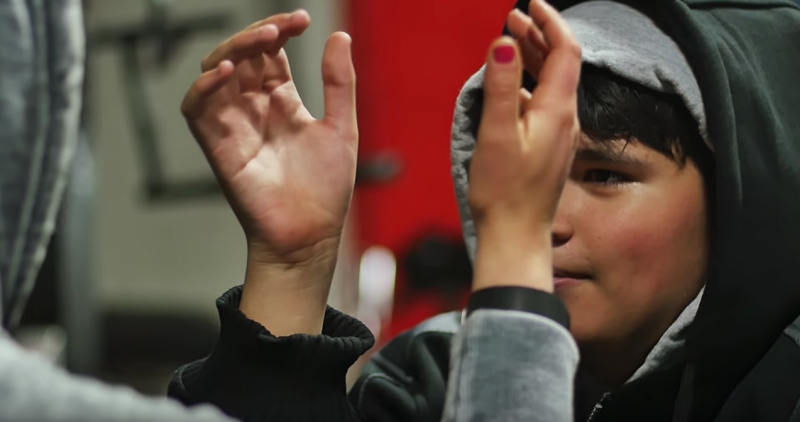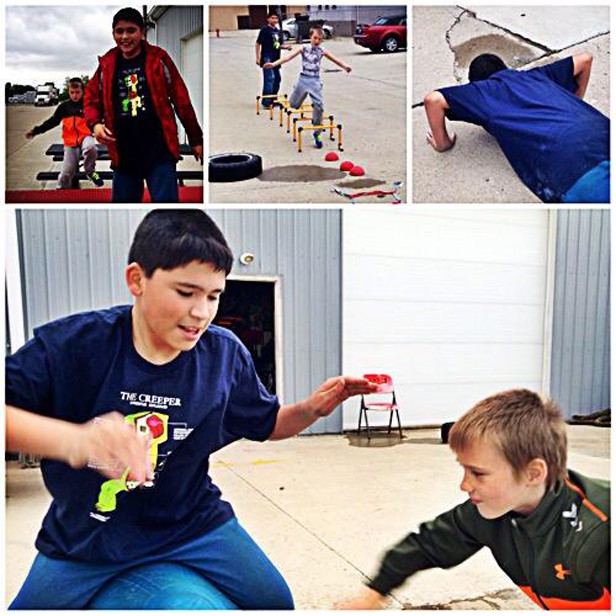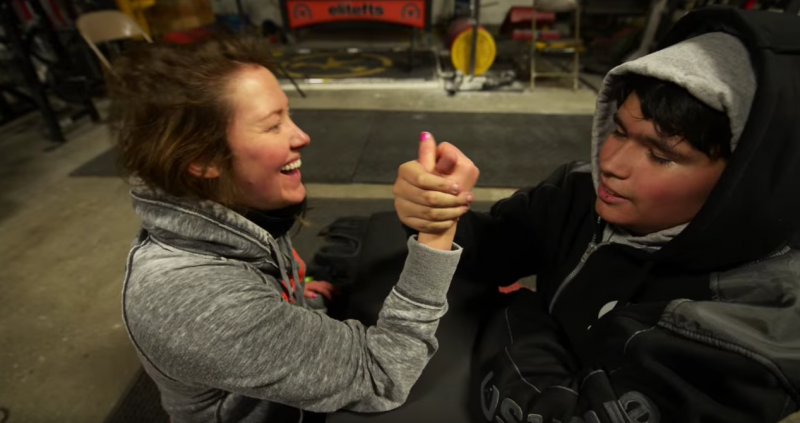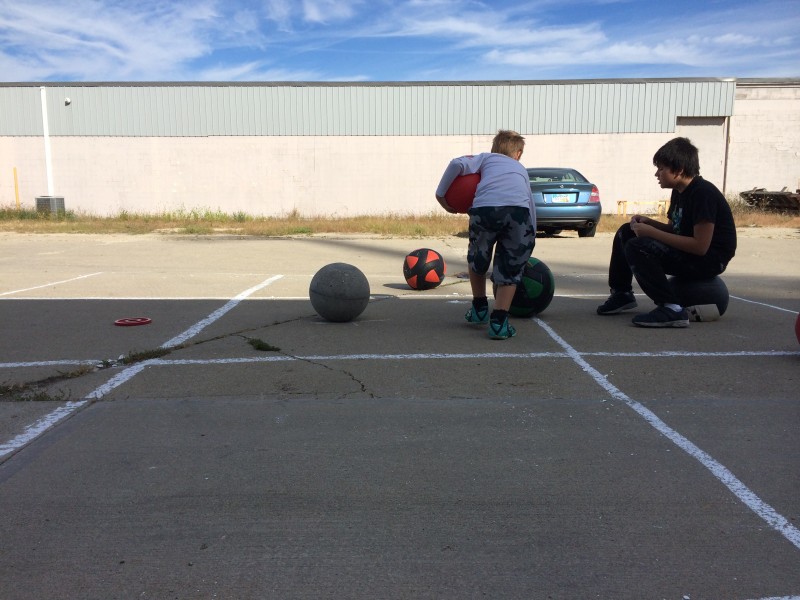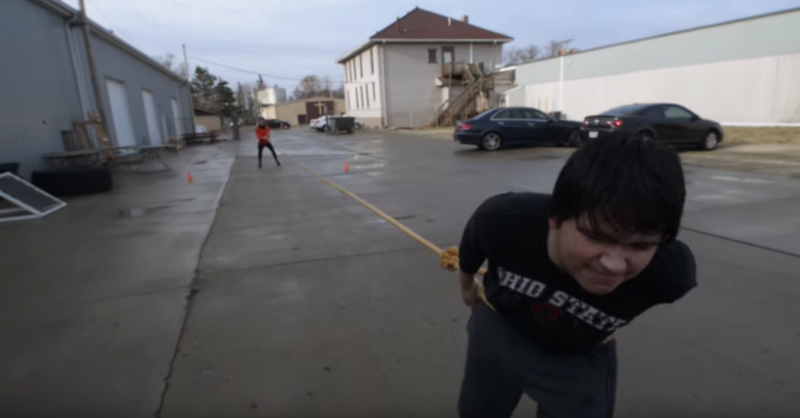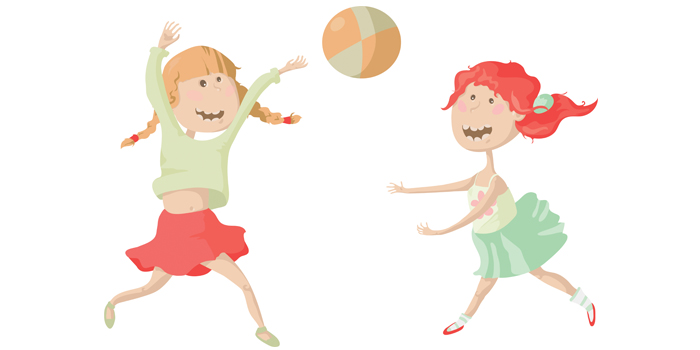
Through witnessing a countless number of programs designed and implemented by individuals interested in creating positive change for children and young adults on the autism spectrum, I’ve seen remarkable advancements in social skills through an active, hands-on/experience-based approach.
This eight-article series provides ideas to advance an inactive, socially craving child/young adult into a physically and socially strong individual through movement and strength. We begin at the gym and through progressive types of training travel off-site, shifting from one-to-one training to group training, to play dates with friends (one example, mind you).
RECENT: Zoo RunRun — Blaine Crosses the Finish Line in His First 5K
In the previous three training types, social interaction and engagement continues to mature as the environmental climate of training moves in new directions. More and more, our overall experience hinges on our ability to connect, first with one and another, and then with those surrounding us. In this type of training, we’re taking things one step further — we share the training experience with a partner.
½ One-to-one, ½ Training Partner
What, Where
This type of training takes place in the gym setting. It’s a weekly commitment to complete movement-based objectives inside the gym individually (with trainer and client) and then transfer our training efforts to include a training partner within a 30-60 minute session.
The training partner may be a friend or sibling (someone who is around the same age or training age with or without autism). In this type of training we are introducing the concepts of sharing time, space, and equipment with one another and learning how working together influences our overall training experience.
Social Integration
No longer is it by chance that our network expands or we’re using our basic gym etiquette skills to politely engage with another in passing. Instead, in this training type we’re allotting specific time within a training session for the client to train with a partner.
Here are a few primary benefits of this training type (in no particular order):
Self-Awareness. A greater awareness of our actions and its effect on one another becomes a new training demand. It’s less about you and me, and more about the group and how the group can and will move forward.
New Training Associations. The training associations set up thus far begin to resituate, as now there are new rules, changes in time distribution, modified goals, and an emphasis on flexibility. Training therefore takes on a whole new meaning.
Teacher/student role-playing. There will be many instances where the children take turns playing an active role as the teacher or student. You’ll see this in motion when you present an activity on the schedule and one child is familiar with it and the other child is not. This exchange between the two exemplifies problem solving, listening, understanding, assertiveness, and personalization. As the trainer, this is a pretty cool moment to see your previous lessons move full circle as a child passes their knowledge to another.
Motivation. It’s amazing how this partnership creates a positive dynamic that pushes both children out of their comfort zones. If paired correctly, a client’s demeanor takes a 180 and she tries something that would otherwise be perceived as threatening and self-defeating. In this case, it’s motivating to work with a friend (especially someone we like) who perceives hard work as pleasurable and attainable. This extends to the child who is focused on only work and uninterested in play.
Play date Opportunity. By attending social groups at OSU with young adults on the spectrum, I have seen a reoccurring social dilemma voiced by this population: the logistics of planning and scheduling time to hang out. The desire is there but the how-to is often missing, therefore many opportunities are missed. In this training type, the trainer coordinates schedules and expectations and may extend these duties to help guide play date logistics (with the help of parents) so the two partners can hang out, if appropriate, outside of the gym on their own terms.
Parent-breakout session. As parents wait as their children are training, this is a great opportunity for them to relax and chat. We can count on the fact that both parties have something in common (what ever it may be) and this mutual bond can develop further to create a support system as they meet weekly. It’s possible that without this commitment, a partnership would otherwise be flaky or non-existent.
Finding A Match
There are countless dynamics to tap into that’ll make this training type benefit both children. Similar to all relationships — this too will take time and effort. Keep this in mind: even if you find the “perfect match”, HOW the session is planned and coordinated makes a tremendous impact.
The training partner may be a friend or sibling, someone who is around the same age or training age with or without autism.
In my experience, here are a few pairing examples that deemed to be beneficial when using this type of training — I’d never imagine some of these combinations would sync but surprisingly they did. These social dynamics may give you some ideas of children/adults that may serve as a great training partner for your child, shining light on those you’d otherwise never consider. In every scenario, the goal remains the same: in a team setting, movement and strength is associated with fun, play, challenge, teamwork, and a positive attitude.
Michael and Brittney: Michael and Brittney are brother and sister. Michael is on the autism spectrum and Brittney is neurotypical. Brittney is two years older than Michael and serves as “the caregiver.” She is sensitive to Michael’s needs and knows what makes him tick. She pushes him to be better and finds great pleasure in seeing her brother excel. Having him by her side calms and motivates him.
RECENT: Social Skill Integration Through Movement and Strength — Off-Site Training
Zach and Hunter: Zach and Hunter are brothers. Zach is on the spectrum and Hunter is neurotypical. They are complete opposites and at home they are enemies. In a structured environment, animosity dissolves and their energies go towards competition. The concepts of taking turns, patience, paying attention, and working together naturally are part of the session because these are the only ways these two can keep tabs on each other to further fuel performance. Blaine and his brother Bryce have this same dynamic and pairing the two in the gym or off-site training has had the same positive effect.
Blaine and Wesley: Blaine and Wesley are school friends. They both are on the autism spectrum. Aside from the love of gaming, these two are complete opposites. Blaine is driven by play and fun. Wesley is driven by skill acquisition and work. Because they get along so well, each is willing to move out of their comfort zones within this session — Blaine performs work he’d otherwise want nothing to do with to appease Wesley and Wesley is interested in playing games and having fun to appease Blaine.
Planning Behind the Schedule
Time Management
Based on the dynamics dependent on the children involved, each session will be set up differently. In any case, a chunk of the session will include individualized attention and another chunk of time will provide peer involvement. Using the scenarios above to give examples, Michael received individual attention for 30 minutes (one-to-one with me) and then Brittney was part of the session for the remaining 30 minutes. In Blaine’s and Wesley’s case, both were receiving individualized time so I set up the session that Blaine was one-to-one for the first 30 minutes, followed by 30 minutes of partner work, followed by 30 minutes of one-to-one work with Wesley.
One-to-One Work
This chunk of time is set up per usual with the intent of completing intensive, individualized work. Derived from your short and long-term goals—and most importantly, where the child is today—this part of gym training is what you won’t be able to accomplish when the partner arrives. Its design is to etch your way towards his short and long-term goals. Gauge where the child is today and how this may affect group work. Remain flexible and make changes to the plan if necessary.
Early on, this time may solely be used as a transitional piece to prepare the child for group work. Watch as its purpose changes and you can insert the intensive work with minimal transitional prep or eliminate it completely.
Partner Work
For partner work, the overall idea is that when the children are together, you’re creating an inviting environment that helps both of the children work as a unit to maneuver in and outside of their comfort zones.
Use this planning period to expand upon previous social experiences and lessons. What can be accomplished now that you’re structuring specific time with a partner to perform a set of activities in a predetermined amount of time? Knowing the personalities of the two, how can one feed off from the other to display feats of effort that would otherwise remain dormant? What ways can you bounce back and forth between their predetermined roles and allow them to switch roles, play the same role, or try something new?
A reoccurring concept that should be constant is that by helping one another in the gym (through compromise, patience, positivity, respect, manners, teamwork, trust, etc.), together we’re having lots of fun, we’re achieving things we didn’t think were capable, and we’re getting physically and mentally stronger (so ultimately we can do the things we love).
As you plan, although our efforts are for the group, continue to answer “what’s in this for me?” as you select your activities. I can’t stress it enough: the children have to see the personal connection in each workout selection and sense your engagement.
Schedule
The schedule is a rough sketch to provide order. I mention that it’s a rough sketch because you should use it as a flexible plan — it’s what you’d like to accomplish in a perfect world but you must also be fully in acceptance of change and disorder. Make it interactive: display so everyone can see it, read and review together, negotiate if appropriate, take turns marking off accomplished tasks, answer/ask questions, etc.
You’re not listing all the social skill opportunities unless not listing them would result in adverse behavior (small cues are acceptable). What is listed (the order, the amount of rest, the types of exercises/activities, the overall time frame, expected wait time, form of transportation, parties involved, game rules, free time, etc.,) is presented to both children in hopes of accomplishing whatever it is you’re looking to accomplish, short and long-term.
To give you something tangible to work with, here is an example of a 60-minute schedule. Obviously your plan will look much different depending upon the needs of the children and the resources available, but it will at least give you pace, ideas of how to organize a plan, activity ideas, and ways to maximize space. Through the selection, make special note of how social order will naturally occur. Notes to follow.
60-minute Schedule Outline
One-to-One (30 minutes)
5 minutes: Welcome at Gym/Brief with Parents
- Meet and Greet
- Review 30-minute Schedule
5 minutes: Warm-up
5 minutes: Bike — transition from tricycle to bicycle – kickstand and straddle
5 minutes: Fine motor work: Lace up shoe
5 minutes: Choice of Game or exercise
5 minutes: Transition to Peer Work
___________________________________________________________________________
Partner Work (30 minutes)
5 minutes: Welcome at Gym/Brief with Parents
- Meet and Greet
- Review 30-minute Schedule
5 minutes: Sled pull relay for time
5 minutes: Rest/Drink/Snack
5 minutes: Strength:Med ball chest press/Shrek Rope Pulls
5 minutes: Game: Foam roller jousting
5 minutes: Goodbye/ Brief with Parents
Notes
This is a schedule example where one child receives one-to-one work and then is joined by a partner for an additional 30 minutes.
In the one-to-one work we begin the session with a welcome, parent briefing, and schedule review. After a warm-up, the intensive work for the day includes transitioning from a tricycle to a bicycle and learning how to lace a shoe. Working with the bike, today the back wheels are taken off so we’re working on flipping the kick stand up while holding onto the handles and swinging one leg over the bike, feeling the bike beneath us (we have to hold it up, it sways back and forth between our legs, we’re suddenly in control). For fine motor work, we merely lacing up our shoes — no tying in this lesson. In the remaining five minutes, after the child chooses a game/exercise of his or her choice, we begin transitioning to peer work.
The partner work begins similarly with a welcome, parent briefing, and schedule review. The sled pull relay is a partner activity that involves one sled and a marked distance. At every cone, the partners switch positions and drag the sled to the next cone until the destination is reached. Time this obstacle and make it a goal to progressively shave off time. As a group, the two have to work together to get from point A to point B. As a working strategy, they have to pay attention to each other’s movements, be cooperative, move quickly, and coach one another (cues for legs and arms to keep moving, time calls, to brace, stand tall, chest up, etc.).
The rest with food and drink is a mid-way point to talk, relax, review the schedule, discuss what was just accomplished, and strategize.
For strength we set up on the flat bench and use a med ball to press. At this point, we are beginning to coach proper pressing basics — foot placement, tightness, back involvement, and movement of ball from chest to lockout. As one partner goes, the other watches and waits her turn. After both children have completed their set, they move onto Shrek Rope Pulls. This is essentially a single-arm seated rope row. The idea is to move Shrek (and weight) from the floor to the ceiling then back to the floor. As one partner goes, the other watches and waits her turn. Rest and repeat.
Foam roller jousting places the children within a 12’x 12’ square. The goal is have the foam roller in hand, make contact with the opponents foam roller, and through force of each hit move the opponent outside of the perimeter. Play for three rounds. In future sessions, lessen the square size, play for more rounds, or alter the activity in another way.
Close the session with a review of everything we accomplished, things we need to work on, what we can expect for next week, and anything else pertinent to the day’s performance. This is also a great time to give special recognition to small improvements: skill wise and/or socially based.
Transition to Next Training Type
In the next training type, we move from ½ One-to-one, ½ Training Partner to Group Training. This type of training takes place in the gym setting. It’s a weekly commitment to complete movement-based objectives inside the gym with a training partner.
Ideally, this session involves the same peer from the previous type of training. The only difference between this and the previous type is now we’re ready to complete the entire workout with a buddy. Similar to ½ One-to-one, ½ Training Partner, the key is creating an environment where both clients thrive for the duration of the session. The union is providing opportunity for each child that would otherwise be non-existent.
Thanks for reading. Please use the comments section below to ask any questions. I’d love to help any way I can.
WHOLE SERIES









